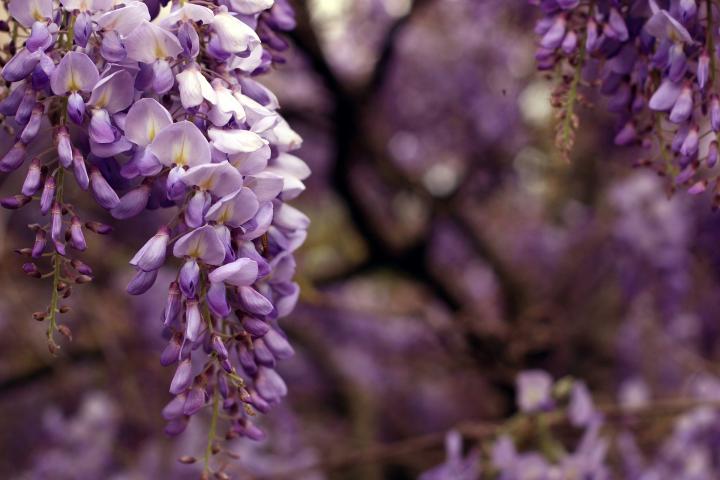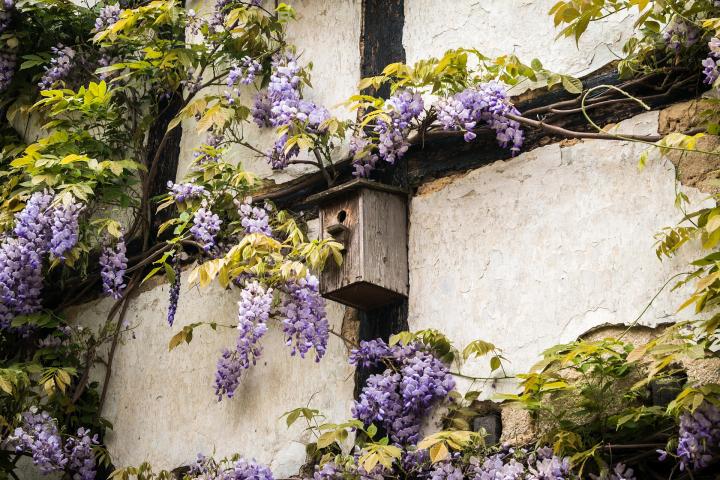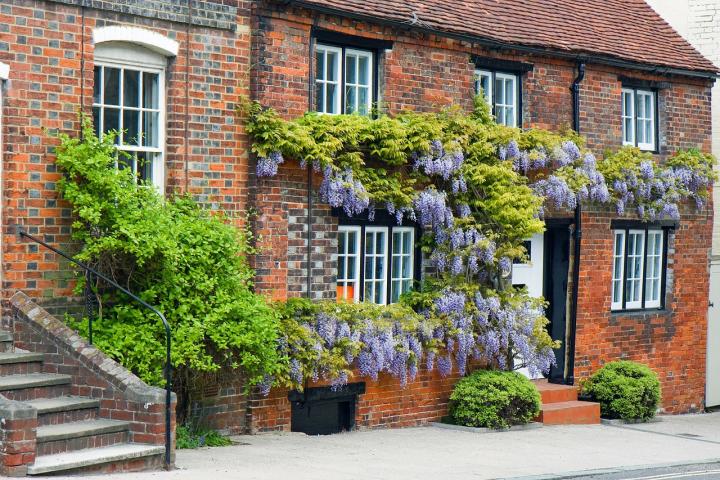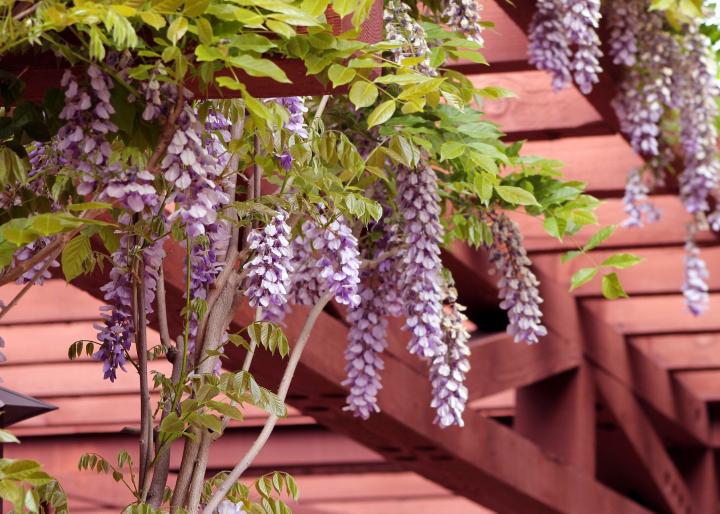
Planting, Growing, and Pruning Wisteria
The Almanac Garden Planner - Use It Free for 7 Days!
Plan your 2025 garden with our award-winning Garden Planner.
Types
Native Wisteria
If you are located in North America, consider planting a species of wisteria native to the continent, such as:
- American wisteria (W. frutescens) grows in Zones 5 to 9. It’s native to a range of states covering Virginia to Texas, southeast to Florida and north up through New York, Iowa, and Michigan. The vine grows 25 to 30 feet long with shiny dark-green leaves and large, drooping lilac or purple-blue flower clusters, which appear after the plant has leafed out. The blooms will only appear on new wood. However, note that the flowers tend to be more lightly fragrant than the Asian wisterias’ flowers.
- Kentucky wisteria (W. macrostachya) grows in Zones 4 to 9. This late-season bloomer is native to the southeastern U.S. and is similar to American wisteria (it is sometimes considered a variety or subspecies of American wisteria). Kentucky wisteria bears mildly fragrant bluish-purple flowers after growing only 2 to 3 years, making it the quickest wisteria to bloom.
- ‘Blue Moon’ is an extra-hardy cultivar of native Kentucky wisteria, with showy silvery-blue clusters. It blooms in late spring or early summer. It’s cold hardy to –30°F.
Non-Native Wisteria
- Chinese wisteria (W. sinensis) and Japanese wisteria (W. floribunda) are non-native, invasive species, so we do not recommend them for North American gardens, despite the fact that they are regularly sold at nurseries and garden centers. They are hardy in Zones 5 to 9 and are capable of growing 30 to 60 feet in length (and beyond in the Southern U.S.). Two common varieties of Japanese wisteria include:
- ‘Honbeni’ (syn. ‘Honko’): popular, bears clusters of pink flowers in late spring
- ‘Alba’ (syn. ‘Shiro Noda’): bears lovely clusters of pure-white flowers in late spring

ADVERTISEMENT
I live in Bullhead City AZ about 2 blocks from river. A friend of mine in Indiana last year pulled up some of her Wisteria and brought the bar root plants out to me. I put them in 6" pots and set them in my car port They All seam to be growing OK. My question is will they survive being planted here. It is not uncommon to have 100* days in the summer and about 2 weeks of 115* On of the plants even has a Tulip terr growing in with it. I know they are not suppose to grow in AZ let alone in the desert. DO I plant all these plants or just get Larger post?
According to the cooperative extension services in your state, you can grow it, with attention to placement (not south- or west-facing exposures), for example. Also, the lack of winter conditions/temps may mean that dormancy is not induced so flowers are fewer or not in appearance See this page for more details: http://www.public.asu.edu/~camartin/plants/Plant%20html%20files/wisteriasinensis.html
You can also contact the service directly here: https://extension.arizona.edu/
I have bought yellow bonsai seeds, are they just a regular wisteria seeds? was I taken, for a fool?
Hello, I’m Ivan from the Philippines. I bought my wisteria plant in Japan an brought here in the Philippines, i would like ask if it can survive in our climate? I have read some of your articles that it needs full sun to bloom, does it means thats okay with our tropical climate? Thanks in advance.
Did your wisteria survived in tropic?
Looking for comments on whether my wisteria is dying - it's been planted for 4 yrs and doing well. Last year I did notice it didn't bloom quite as well as prior years but didn't think of it until this year when I noticed a trunk split and possibly trunk rot toward the bottom. I'm not sure why this has occurred as I'm in southern Ontario and was under the impression wisteria could tolerate winters. As of today's date it does not look as though the plant is doing anything - no buds and no green yet. Should I be pulling it and starting over or will it bounce back with care to the trunk?
Hi, Alycia: This is difficult to diagnose without seeing, but we would probably try to bind the trunk together and see what happens with the upcoming warmer weather. At the same time, be watchful for hardy new shoots from your roots. If you see the latter and are having no success with the former, then go ahead and cut the old trunk off so that the plant can focus its energy on its new growth. Thanks for asking and good luck!
Hello, my fiance and I enjoy gardening very much. We have a wide variety of exotic plants from 8 different species of orchids, gardenia, birds of paradise, hibiscus and even carnivorous plants all in our custom mini greenhouse we built inside our bedroom in an alcove that previously served no purpose. All the plants are surrounded by powerful led and fluorescent grow lights and we would like to start a bonsai wisteria from seeds we purchased. Is it difficult to grow a wisteria from seed? Also, do they do well in containers if kept well pruned? And, if grown from seed, how long would it be for the plant to mature to a flowering state?
Wow! How interesting and unique! Wisteria would qualify as a plant that makes good bonsai. It has small leaves, survives intense pruning, and other factors. While wisteria will seed fairly easily, the plant takes many years to reach blooming age (10 to 15 years) so it’s up to your timetable! If you seed, use a big pot to promote growth of roots. If you don’t have a decade to wait for a bloom, get one with a trunk ready to pot and prune.
Hi wonder if you can help i havd a problem with my wisteria it has little nobs on all the branches and a sticky substance is dropping from it any suggestons on what is wrong













